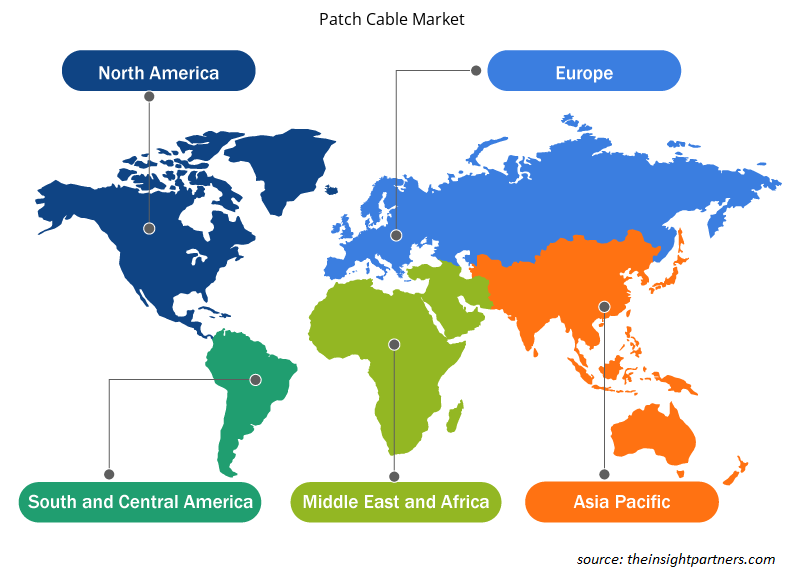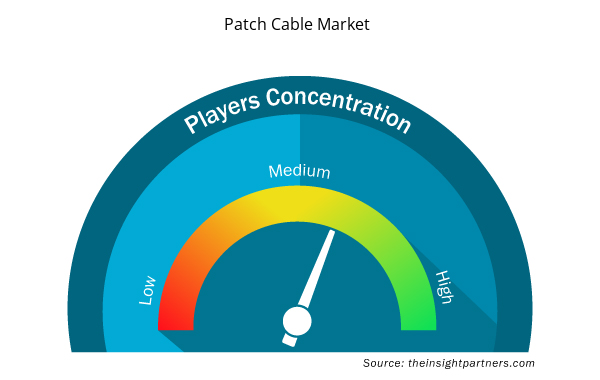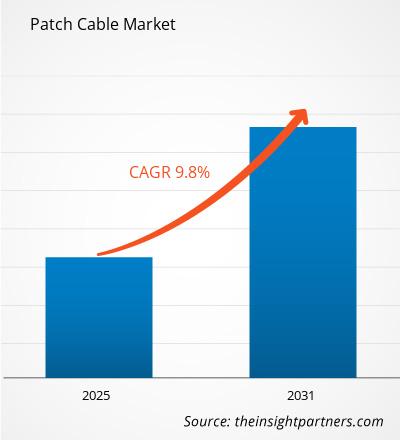Se espera que el mercado de cables de conexión registre una CAGR del 9,8 % entre 2023 y 2031, con un tamaño de mercado que se expandirá de US$ XX millones en 2023 a US$ XX millones en 2031.CAGR of 9.8% from 2023 to 2031, with a market size expanding from US$ XX million in 2023 to US$ XX Million by 2031.
El informe está segmentado por tipo (cable de cobre, fibra óptica); tipo de cable (Cat5, Cat6, Cat5e, Cat6a, Cat7, RG6, fibra óptica multimodo, otros); área de aplicación (redes, no redes); usuario final (empresa, seguridad de redes y TI, transmisión, industrial, otros). El análisis global se desglosa aún más a nivel regional y por países principales. El informe ofrece el valor en USD para el análisis y los segmentos anteriores.
Propósito del Informe
El informe Patch Cable Market de The Insight Partners tiene como objetivo describir el panorama actual y el crecimiento futuro, los principales factores impulsores, los desafíos y las oportunidades. Esto proporcionará información a diversas partes interesadas del negocio, como:
- Proveedores/fabricantes de tecnología: Para comprender la dinámica cambiante del mercado y conocer las oportunidades potenciales de crecimiento, lo que les permitirá tomar decisiones estratégicas informadas.
- Inversionistas: Realizar un análisis exhaustivo de tendencias sobre la tasa de crecimiento del mercado, las proyecciones financieras del mercado y las oportunidades que existen en toda la cadena de valor.
- Órganos reguladores: Regular las políticas y vigilar las actividades del mercado con el objetivo de minimizar los abusos, preservar la confianza de los inversores y defender la integridad y estabilidad del mercado.
Segmentación del mercado de cables de conexión
Tipo
- Cable de cobre
- Fibra óptica
Tipo de cable
- Cat5
- Categoría 6
- Cat5e
- Cat6a
- Cat7
- RG6
- Fibra óptica multimodo
- Otros
Área de aplicación
- Redes
- Sin redes
Usuario final
- Empresa
- Seguridad informática y de redes
- Transmisión
- Industrial
- Otros
Usuario final
- Empresa
- Seguridad informática y de redes
- Transmisión
- Industrial
- Otros
Personalice este informe según sus necesidades
Obtendrá personalización en cualquier informe, sin cargo, incluidas partes de este informe o análisis a nivel de país, paquete de datos de Excel, así como también grandes ofertas y descuentos para empresas emergentes y universidades.
- Obtenga las principales tendencias clave del mercado de este informe.Esta muestra GRATUITA incluirá análisis de datos, desde tendencias del mercado hasta estimaciones y pronósticos.
Factores impulsores del crecimiento del mercado de cables de conexión
- Creciente adopción de redes 5G: La creciente adopción de redes 5G está transformando fundamentalmente la infraestructura de conectividad, lo que requiere soluciones de cables de conexión avanzadas que puedan soportar velocidades de transmisión de datos sin precedentes y requisitos de baja latencia. La compleja arquitectura de red de 5G exige componentes de conectividad de alto rendimiento que puedan manejar volúmenes de datos masivos, admitir múltiples bandas de frecuencia y mantener la integridad de la señal en topologías de red intrincadas. Los cables de conexión son fundamentales en estas redes, ya que sirven como interconexiones esenciales en estaciones base, celdas pequeñas, infraestructura de red central y entornos de computación de borde.
- Inversiones masivas en actualizaciones de redes de telecomunicaciones: los operadores de telecomunicaciones de todo el mundo están llevando a cabo amplias iniciativas de modernización de redes, reemplazando la infraestructura heredada con redes de comunicación de última generación, lo que impulsa directamente el crecimiento del mercado de cables de conexión. Estas inversiones masivas implican actualizaciones integrales en los sistemas de transmisión, centros de conmutación, centros de datos e infraestructura de conectividad de última milla, lo que requiere un despliegue sustancial de cables de conexión avanzados que puedan soportar velocidades de datos más altas, una mejor calidad de la señal y una mayor confiabilidad de la red.
Tendencias futuras del mercado de cables de conexión
- Cambio hacia cables de mayor ancho de banda (Cat 6A, Cat 7, Cat 8): La migración hacia cables de mayor ancho de banda como Cat 6A, Cat 7 y Cat 8 representa una tendencia evolutiva significativa en la conectividad de red, impulsada por los requisitos de transmisión de datos que aumentan exponencialmente en los sectores empresarial, industrial y de telecomunicaciones. Estas categorías avanzadas de cables ofrecen características de rendimiento sustancialmente mejoradas, que incluyen compatibilidad con frecuencias más altas, diafonía reducida, protección mejorada contra interferencias electromagnéticas (EMI) y velocidades de transmisión de datos significativamente mayores en comparación con sus predecesores.
- Crecimiento de los cables de conexión de fibra óptica: los cables de conexión de fibra óptica están ganando terreno, ya que ofrecen velocidades de transferencia de datos más altas y distancias de transmisión más largas en comparación con los cables de cobre tradicionales. La tendencia está impulsada por la creciente necesidad de servicios de Internet más rápidos, computación en la nube y comunicación a larga distancia en sectores como la atención médica, la educación y los negocios.
Oportunidades de mercado para los cables de conexión
- Desarrollo de infraestructura para ciudades inteligentes: las iniciativas de ciudades inteligentes están generando una demanda sin precedentes de soluciones sofisticadas de cables de conexión, ya que requieren infraestructuras de red extensas e interconectadas que respalden múltiples sistemas urbanos, como la gestión del tráfico, la seguridad pública, el control ambiental, la gestión de los servicios públicos y los servicios a los ciudadanos. Estos complejos ecosistemas en red requieren cables de conexión robustos y de alto rendimiento capaces de soportar diversos protocolos de comunicación, soportar condiciones ambientales adversas y proporcionar una conectividad confiable y de baja latencia a través de redes de sensores, sistemas de vigilancia, mecanismos de control del tráfico y plataformas de comunicación pública.
- Crecientes expansiones de centros de datos y requisitos de computación en la nube: los centros de datos modernos requieren cables de conexión que puedan manejar requisitos de ancho de banda extremadamente altos, admitir múltiples estándares de transmisión, proporcionar una degradación mínima de la señal y ofrecer una densidad y flexibilidad excepcionales en configuraciones de rack de servidores complejas. Estas soluciones de cables de conexión deben admitir tecnologías emergentes como Ethernet de 100 Gbps y 400 Gbps, facilitar la transmisión rápida de datos entre servidores, sistemas de almacenamiento y equipos de red, y brindar un rendimiento sólido en entornos densamente poblados y con desafíos térmicos donde la integridad de la señal y la eficiencia de la transmisión son fundamentales para el rendimiento general del sistema.
Perspectivas regionales del mercado de cables de conexión
Los analistas de Insight Partners explicaron en detalle las tendencias y los factores regionales que influyen en el mercado de cables de conexión durante el período de pronóstico. Esta sección también analiza los segmentos y la geografía del mercado de cables de conexión en América del Norte, Europa, Asia Pacífico, Oriente Medio y África, y América del Sur y Central.

- Obtenga datos regionales específicos para el mercado de cables de conexión
Alcance del informe de mercado de cables de conexión
| Atributo del informe | Detalles |
|---|---|
| Tamaño del mercado en 2023 | XX millones de dólares estadounidenses |
| Tamaño del mercado en 2031 | US$ XX millones |
| CAGR global (2023 - 2031) | 9,8% |
| Datos históricos | 2021-2022 |
| Período de pronóstico | 2024-2031 |
| Segmentos cubiertos | Por tipo
|
| Regiones y países cubiertos | América del norte
|
| Líderes del mercado y perfiles de empresas clave |
|
Densidad de actores del mercado de cables de conexión: comprensión de su impacto en la dinámica empresarial
El mercado de cables de conexión está creciendo rápidamente, impulsado por la creciente demanda de los usuarios finales debido a factores como la evolución de las preferencias de los consumidores, los avances tecnológicos y una mayor conciencia de los beneficios del producto. A medida que aumenta la demanda, las empresas amplían sus ofertas, innovan para satisfacer las necesidades de los consumidores y aprovechan las tendencias emergentes, lo que impulsa aún más el crecimiento del mercado.
La densidad de actores del mercado se refiere a la distribución de las empresas o firmas que operan dentro de un mercado o industria en particular. Indica cuántos competidores (actores del mercado) están presentes en un espacio de mercado determinado en relación con su tamaño o valor total de mercado.
Las principales empresas que operan en el mercado de cables de conexión son:
- Corporación Caja Negra
- Información de contacto de CommScope, Inc.
- Corning Incorporated
- Legrand
- Nexans
Descargo de responsabilidad : Las empresas enumeradas anteriormente no están clasificadas en ningún orden particular.

- Obtenga una descripción general de los principales actores clave del mercado de cables de conexión
Puntos de venta clave
- Cobertura integral: el informe cubre de manera integral el análisis de productos, servicios, tipos y usuarios finales del mercado de cables de conexión, proporcionando un panorama holístico.
- Análisis de expertos: el informe se compila sobre la base de un profundo conocimiento de expertos y analistas de la industria.
- Información actualizada: El informe asegura relevancia comercial debido a su cobertura de información reciente y tendencias de datos.
- Opciones de personalización: este informe se puede personalizar para satisfacer los requisitos específicos del cliente y adaptarse adecuadamente a las estrategias comerciales.
Por lo tanto, el informe de investigación sobre el mercado de cables de conexión puede ayudar a abrir el camino para descifrar y comprender el escenario de la industria y las perspectivas de crecimiento. Si bien puede haber algunas preocupaciones válidas, los beneficios generales de este informe tienden a superar las desventajas.
- Análisis histórico (2 años), año base, pronóstico (7 años) con CAGR
- Análisis PEST y FODA
- Tamaño del mercado Valor/volumen: global, regional, nacional
- Industria y panorama competitivo
- Conjunto de datos de Excel



Report Coverage
Revenue forecast, Company Analysis, Industry landscape, Growth factors, and Trends

Segment Covered
This text is related
to segments covered.

Regional Scope
North America, Europe, Asia Pacific, Middle East & Africa, South & Central America

Country Scope
This text is related
to country scope.
Preguntas frecuentes
Some of the customization options available based on the request are an additional 3-5 company profiles and country-specific analysis of 3-5 countries of your choice. Customizations are to be requested/discussed before making final order confirmation# as our team would review the same and check the feasibility
The report can be delivered in PDF/PPT format; we can also share excel dataset based on the request
Rising adoption of 5G networks and massive investments in telecom network upgrades are the major factors driving the patch cable market
Shift towards higher bandwidth cables (Cat 6A, Cat 7, Cat 8) is anticipated to play a significant role in the global patch cable market in the coming years
The Patch Cable Market is estimated to witness a CAGR of 9.8% from 2023 to 2031
Trends and growth analysis reports related to Electronics and Semiconductor : READ MORE..
1. Black Box Corporation
2. CommScope, Inc.
3. Corning Incorporated
4. Legrand
5. Nexans
6. Panduit Corp.
7. Phoenix Contact
8. Prysmian Group
9. Quabbin Wire and Cable Co., Inc.
10. Schneider Electric SE
The Insight Partners performs research in 4 major stages: Data Collection & Secondary Research, Primary Research, Data Analysis and Data Triangulation & Final Review.
- Data Collection and Secondary Research:
As a market research and consulting firm operating from a decade, we have published and advised several client across the globe. First step for any study will start with an assessment of currently available data and insights from existing reports. Further, historical and current market information is collected from Investor Presentations, Annual Reports, SEC Filings, etc., and other information related to company’s performance and market positioning are gathered from Paid Databases (Factiva, Hoovers, and Reuters) and various other publications available in public domain.
Several associations trade associates, technical forums, institutes, societies and organization are accessed to gain technical as well as market related insights through their publications such as research papers, blogs and press releases related to the studies are referred to get cues about the market. Further, white papers, journals, magazines, and other news articles published in last 3 years are scrutinized and analyzed to understand the current market trends.
- Primary Research:
The primarily interview analysis comprise of data obtained from industry participants interview and answers to survey questions gathered by in-house primary team.
For primary research, interviews are conducted with industry experts/CEOs/Marketing Managers/VPs/Subject Matter Experts from both demand and supply side to get a 360-degree view of the market. The primary team conducts several interviews based on the complexity of the markets to understand the various market trends and dynamics which makes research more credible and precise.
A typical research interview fulfils the following functions:
- Provides first-hand information on the market size, market trends, growth trends, competitive landscape, and outlook
- Validates and strengthens in-house secondary research findings
- Develops the analysis team’s expertise and market understanding
Primary research involves email interactions and telephone interviews for each market, category, segment, and sub-segment across geographies. The participants who typically take part in such a process include, but are not limited to:
- Industry participants: VPs, business development managers, market intelligence managers and national sales managers
- Outside experts: Valuation experts, research analysts and key opinion leaders specializing in the electronics and semiconductor industry.
Below is the breakup of our primary respondents by company, designation, and region:

Once we receive the confirmation from primary research sources or primary respondents, we finalize the base year market estimation and forecast the data as per the macroeconomic and microeconomic factors assessed during data collection.
- Data Analysis:
Once data is validated through both secondary as well as primary respondents, we finalize the market estimations by hypothesis formulation and factor analysis at regional and country level.
- Macro-Economic Factor Analysis:
We analyse macroeconomic indicators such the gross domestic product (GDP), increase in the demand for goods and services across industries, technological advancement, regional economic growth, governmental policies, the influence of COVID-19, PEST analysis, and other aspects. This analysis aids in setting benchmarks for various nations/regions and approximating market splits. Additionally, the general trend of the aforementioned components aid in determining the market's development possibilities.
- Country Level Data:
Various factors that are especially aligned to the country are taken into account to determine the market size for a certain area and country, including the presence of vendors, such as headquarters and offices, the country's GDP, demand patterns, and industry growth. To comprehend the market dynamics for the nation, a number of growth variables, inhibitors, application areas, and current market trends are researched. The aforementioned elements aid in determining the country's overall market's growth potential.
- Company Profile:
The “Table of Contents” is formulated by listing and analyzing more than 25 - 30 companies operating in the market ecosystem across geographies. However, we profile only 10 companies as a standard practice in our syndicate reports. These 10 companies comprise leading, emerging, and regional players. Nonetheless, our analysis is not restricted to the 10 listed companies, we also analyze other companies present in the market to develop a holistic view and understand the prevailing trends. The “Company Profiles” section in the report covers key facts, business description, products & services, financial information, SWOT analysis, and key developments. The financial information presented is extracted from the annual reports and official documents of the publicly listed companies. Upon collecting the information for the sections of respective companies, we verify them via various primary sources and then compile the data in respective company profiles. The company level information helps us in deriving the base number as well as in forecasting the market size.
- Developing Base Number:
Aggregation of sales statistics (2020-2022) and macro-economic factor, and other secondary and primary research insights are utilized to arrive at base number and related market shares for 2022. The data gaps are identified in this step and relevant market data is analyzed, collected from paid primary interviews or databases. On finalizing the base year market size, forecasts are developed on the basis of macro-economic, industry and market growth factors and company level analysis.
- Data Triangulation and Final Review:
The market findings and base year market size calculations are validated from supply as well as demand side. Demand side validations are based on macro-economic factor analysis and benchmarks for respective regions and countries. In case of supply side validations, revenues of major companies are estimated (in case not available) based on industry benchmark, approximate number of employees, product portfolio, and primary interviews revenues are gathered. Further revenue from target product/service segment is assessed to avoid overshooting of market statistics. In case of heavy deviations between supply and demand side values, all thes steps are repeated to achieve synchronization.
We follow an iterative model, wherein we share our research findings with Subject Matter Experts (SME’s) and Key Opinion Leaders (KOLs) until consensus view of the market is not formulated – this model negates any drastic deviation in the opinions of experts. Only validated and universally acceptable research findings are quoted in our reports.
We have important check points that we use to validate our research findings – which we call – data triangulation, where we validate the information, we generate from secondary sources with primary interviews and then we re-validate with our internal data bases and Subject matter experts. This comprehensive model enables us to deliver high quality, reliable data in shortest possible time.


 Obtenga una muestra gratuita de este informe
Obtenga una muestra gratuita de este informe